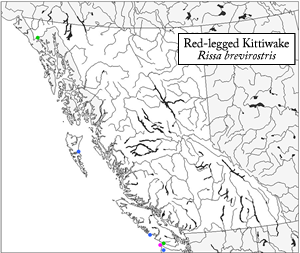The bright red legs and feet of adult and older immature individuals render them virtually unmistakable if this feature is observed, but because distance or conditions may prevent observation of the feet, and because occasional Black-legged Kittiwakes may show pale orangey feet, this feature should not be relied upon for all observations. Adults are most similar to adult Black-legged Kittiwake, but can be distinguished by their smaller size, distinctly shorter and stubbier bill, relatively larger eye, and, perhaps most importantly, their darker grey upperparts that differ noticeably from the paler grey upperparts of adult Black-legged Kittiwake. In flight Black-legged Kittiwakes typically show a slight contrast between the paler grey primaries and darker grey upperwing coverts, whereas the upperwings of Red-legged Kittiwake are uniformly darker grey. Furthermore, the undersides of the primaries and secondaries of Red-legged Kittiwake are pale grey, contrasting with the whitish-grey underwing coverts, whereas the underwings of Black-legged Kittiwake are entirely white.
Juveniles and first-winter immatures are very different from juvenile Black-legged Kittiwake in that they have darker grey upperparts that lack the bold black ‘W’ extending across the outer primaries, primary coverts, and upperwing coverts. Juvenile Black-legged Kittiwake also shows a much blacker and sharply-defined black collar across the nape and has a narrow black terminal band across the tip of the tail (tail of juvenile Red-legged Kittiwake is entirely white). The underwings are much whiter in juvenile Black-legged Kittiwake, showing only a narrow black tip to the primaries, whereas the underside of the wings of juvenile Red-legged Kittiwake are more greyish-white with much more extensive black tips. Juvenile Red-legged Kittiwake may be more likely to be confused with juvenile or adult Sabine’s Gull due to the bold white ‘triangle’ or ‘wedge’ across the trailing edge of the upperings. The upperwing pattern of Sabine’s Gull is even bolder, however, with a cleaner and more sharply-defined black wedge on the outer primaries and primary coverts. Adult Sabine’s Gull usually shows a complete blackish head, but in the case of immature birds they can be distinguished by the partial dark grey hood that does not extend onto the lower nape. Juvenile Sabine’s Gulls can be further distinguished by their scaly brownish upperparts and black terminal band on the tail. Juvenile Red-legged Kittiwake also bears a slight resemblance to adult and juvenile Ross’s Gull, due primarily to the whitish ‘triangle’ that is visible across the flight feathers on the underwing. Ross’s Gull is easily distinguished, however, by its smaller size, wedge-shaped tail, and very pale grey upperparts. Juvenile Ross’s Gull shows a blackish ‘W’ across the upperwings that resembles that of juvenile Black-legged Kittiwake but is not shown by juvenile Red-legged Kittiwake.
|
The Red-legged Kittiwake feeds virtually exclusively on small marine fish (<10 cm in length) and marine invertebrates such as squid, amphipods, and other zooplankton. Most foraging is done over very deep marine waters, usually beyond the continental shelf (even during the breeding season), and prey is captured primarily by shallow plunge-dives or by dipping. It often occurs with flocks of Black-legged Kittiwakes when foraging, and two of the three British Columbia records are of single individuals associating with larger flocks of Black-legged Kittiwakes. Both species of kittiwake forage during both day and night, but the relatively larger eye of the Red-legged Kittiwake suggests that it may be more prone to nocturnal foraging.
Source: Byrd and Williams (1993)
|

